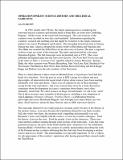Operation Epsilon: Science, History, and Theatrical Narrative
Author(s)
Brody, Alan
DownloadBrody Operation Epsilon.pdf (44.85Kb)
OPEN_ACCESS_POLICY
Open Access Policy
Creative Commons Attribution-Noncommercial-Share Alike
Terms of use
Metadata
Show full item recordAbstract
In 1945, shortly after VE day, the Anglo-American forces rounded up ten renowned nuclear scientists and interned them at Farm Hall, an estate near Cambridge, England. All the rooms on the estate had been bugged. The conversations of the scientists were recorded on wax discs and translated. Information regarding both the scientists' research and anything else that might be of interest to the Anglo-American military was sent to Washington and London. The internship lasted from July to January. During that time, America dropped the atomic bomb on Hiroshima and Nagasaki, and Otto Hahn was awarded the Nobel Prize for his discovery of fission. The men's responses to those events are a part of the transcript. The entire operation had the code name Operation Epsilon. The full transcripts were declassified only in 1993. They were published in England under the title Operation Epsilon: The Farm Hall Transcripts and in the states as Hitler's Uranium Club, superbly edited by Jeremy Bernstein. Besides Hahn, the other scientists were Werner Heisenberg, Max Von Laue, Karl Friederich Von Weizsacker, Paul Harteck, Karl Wirtz, Kurt Diebner Horst Korsching, and Erich Bagge. Bagge and Diebner were the only members of the Nazi party.
Date issued
2011-05Department
Massachusetts Institute of Technology. Department of Humanities. Music and Theater Arts SectionJournal
Narrative
Publisher
Muse - Johns Hopkins University Press
Citation
Brody, Alan. “Operation Epsilon: Science, History, and Theatrical Narrative.” Narrative 19.2 (2011): 253–257.
Version: Author's final manuscript
ISSN
1538-974X